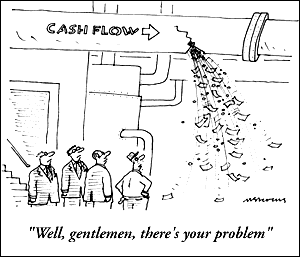Commodity Busting: Be a Price Maker, Not a Price Taker!
Business is about making money, not measuring macho. The scrap heap of corporate disasters is littered with managers whose ego drive overwhelmed good sense..
(originally published by Booz & Company) Ray Noorda had a wonderful business in the company he founded, network software supplier Novell Inc., until he became obsessed with beating the Microsoft Corporation. His battle was futile. He left Novell as it began a long downward slide.
Ray Noorda had a wonderful business in the company he founded, network software supplier Novell Inc., until he became obsessed with beating the Microsoft Corporation. His battle was futile. He left Novell as it began a long downward slide.
The fighter pilot mentality of several United States airlines led to a price war that cost billions of dollars. Even in small protected niche markets like retail security systems -- where the two primary competitors, Checkpoint Systems Inc. and the Sensormatic Electronics Corporation, went at each other mercilessly -- unbridled competition can be destructive.
Sensible managers focus primarily on their own success, not on creating failure for their competitors. Despite intense competition in business, one can win without destroying, or even harming, the competitor. The important thing is to focus on your own success.
Smart competitors don't try to beat their adversaries; they avoid direct competitors and instead maximize profits. The astute manager wants to establish a set of quasi "local monopolies," protected from competitive as well as customer pressure. This demands confidence, not bravado, astute analysis instead of raw aggression, and careful, empathetic focus on the other players in the marketplace.
This is perhaps most true in pricing, a particularly vexing challenge in today's hypercompetitive marketplace. Major customers exert enormous pressure to force suppliers to cut prices. The consolidation of purchases and purchasers adds to the pressure. And competitors, in an attempt to gain share or position, often destroy the profitability of whole markets. But with careful thought and precise execution, managers can be price makers, not price takers.
There are seven steps to becoming a price maker. Each step is crucial -- a failure to take any one will put your company on the slippery slope to becoming a price taker.
Step One: Create customer value. There are really two parts to the creation of customer value. The first is that you must provide a reason for the customer to do business with you. By focusing on the four core customer values -- convenience, availability, product or service functionality and relationship -- you create a reason for the customer to buy.
But you also have to eliminate reasons for the customer not to purchase. Various adjunct services, for example, often described as the steps in the order cycle, can cause serious problems for customers, and create a strong reason not to purchase. Billing in a confusing or incorrect way causes customer annoyance, for example.
Just eliminating the reasons for someone not to purchase, however, does not create a reason to buy. It is necessary to provide a positive attraction for your product or service, as well as to remove the inhibitors to purchase.
The most successful companies follow this two-prong strategy of providing a reason for the customer to buy while eliminating annoying problems in the order cycle. Whether it is Microsoft or Wal-Mart Stores Inc., the balanced approach works best. Wal-Mart, for example, stresses its low prices, which give the customer a reason to buy, while simultaneously providing supportive service, from the greeter at the entrance of the store to the cashier at the exit.
Step Two: The corollary to providing customer value is to choose customers or purchase situations where the value is recognized. Managers are beginning to understand that it is impossible to provide a meaningful reason to purchase, as well as outstanding service, to all customers in all purchase situations. It is absolutely necessary to fit your capabilities to your customers' needs and your customers to your capabilities. You must focus your capabilities where they will mean the most to the customer. The real secret to being a price maker is to walk away from business where you cannot provide superior value.
Focus only on the market segments, defined by customer set or purchase situation, to which you can bring perceived superior value. It is essential to understand that both the perception and the reality are important. Some customers really have no interest in your special capabilities. Avoid those customers. But you must also avoid the prospects who cannot perceive your superior value. Simply put, schizophrenia is terminal in business. Your company must stand for a unique value provided to a unique set of customers or purchase situations.
Step Three: Be different. While many managers talk about uniqueness, when the going gets tough, they attempt to imitate their competitors. To be a price maker, be different! The difference can be in the nature of the customer value that is created, the way it is created or the type of customer for which it is created. The more different you are, the greater the opportunity to set your own price. A commodity is defined as "undifferentiated." You must be different.
Gore Associates, the very successful manufacturer of Gore-Tex, provides unique product functionality. Other successful companies focus on a unique business model, i.e., the way in which they create value. They create value more cheaply, like Wal-Mart, or provide better service, like Nordstrom Inc. Still other successful companies choose to appeal to a different set of customers or purchase situations than their competitors do. The Progressive Corporation, the insurer, built a wonderful business from screening relatively low-risk customers from among generally high-risk motorcyclists.
Step Four: Don't "shoot yourself in the foot" by mismanaging your own product or service line. Many companies offer so many variations with minor differences that customers are encouraged to trade down to lower-margin merchandise or services, or just become so confused that they won't buy. It is difficult enough to compete with others -- do not compete with yourself! By and large, simple product lines and service offerings have proven the easiest to manage, and in the long run, the most profitable to offer.
Step Five: Develop a way to charge for each customer transaction based on either the quality or the quantity of value you provide. Each transaction provides the opportunity to set a price that relates to customer value. To do this, you must focus on the basis of your pricing. For example, when the Xerox Corporation introduced its copying machine, it was neither sold nor leased on a time basis. Instead, a lease meter was installed in each machine to count the number of copies made. This enabled Xerox to charge more from heavy users, who apparently found greater value in the machine, than from light users.
The original basis for pricing telephone service, including both a fixed monthly charge and a usage charge, represents the same kind of thinking. The person who chose to price advertising services as 15 percent of the media buy, instead of by time and materials, created an enormous amount of profit for advertising agencies.
Often services, and to a lesser extent products, can be priced not just by quantity but according to the performance or quality provided. Thus, a computer consultant might be paid based on meeting certain quality benchmarks, or as a percentage of cost savings. Or a contractor might be paid more for finishing a job early. There are many variations to performance-based pricing, including penalty clauses. But the idea is always the same. Base your price on the value the customer is receiving.
Many people who are able to follow the first five requirements find the last two particularly difficult. The first five have an intellectual tone. They involve careful analysis, and detailed conceptual frameworks. But the sixth requirement makes clear that execution is absolutely critical.
Step Six: Deliver on your promise. If you do not deliver on your promise, your customer will have a good reason to negotiate and focus on price. When customers are happy because their expectations are being met, they tend to focus less on price, and generally to be better behaved. For example, there is a great deal of evidence that satisfied customers pay more rapidly than dissatisfied ones. Ask any accounts receivable manager. The final requirement is perhaps the simplest, but may also be the most difficult.
Step Seven: Be courageous. In situations where the size of the transaction is large, customers will often want to negotiate price. For your part, it will often be tempting to cut the price to keep the customer or gain market share. But if the integrity of the price book is eroded, you become a price taker, not a price maker. For example, if you set a price, and announce that it is not negotiable, you must not negotiate. Once you begin to negotiate, you can't be a fixed-price company.
Each of the first six steps requires courage. Providing real value to the customer, for example, requires courage. Choosing certain customers or purchase situations, and consciously walking away from others, requires a much higher degree of courage.
Perhaps being different requires the most courage of all. But the very difference is what will enable you to be a price maker, not a price taker. Courage is in short supply, but it is highly rewarded. ![]()
Reprint No. 98201


